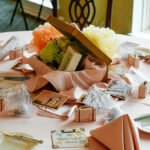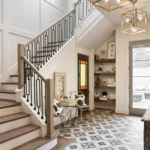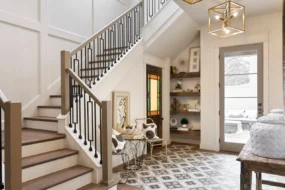
Home improvement projects are often associated with large budgets and contractors, but the truth is, there are countless DIY projects that can improve your home’s functionality, appearance, and value—all without breaking the bank. Whether you’re looking to freshen up a single room or give your entire house a makeover, there are plenty of creative and affordable DIY ideas that will help you transform your space.
In this blog post, we’ll explore 10 budget-friendly DIY home improvement projects that you can easily take on over a weekend. These projects are perfect for beginners and experienced DIY enthusiasts alike and will leave you with a home that feels fresh, modern, and personalized to your taste.
1. Refresh Your Walls with Paint
One of the easiest and most impactful ways to improve the look of any room is with a fresh coat of paint. Whether you’re updating a single wall, painting furniture, or giving the entire room a makeover, painting is an affordable project that can completely change the feel of a space.
Materials Needed:
- Paint (color of your choice)
- Painter’s tape
- Drop cloths or plastic sheets
- Paint roller and brushes
- Paint tray
How to Get Started:
- Prep the Space: Begin by covering your floors and furniture with drop cloths or plastic sheets to protect them from spills. Use painter’s tape to mask off trim, windows, and any areas you don’t want to paint.
- Apply Primer (Optional): If you’re painting over dark colors or on new drywall, applying a primer coat first will ensure that your paint goes on evenly and covers properly.
- Paint the Walls: Start by cutting in around the edges with a brush. Then, use a roller to apply paint to the larger sections of the wall. Be sure to use even strokes to avoid streaks.
- Allow to Dry: Let the paint dry completely before adding a second coat, if needed. Once dry, remove the painter’s tape for clean lines.
A fresh coat of paint can work wonders in brightening up a room, adding new life to tired spaces, and making your home feel more vibrant.
2. Install a Backsplash in the Kitchen
A kitchen backsplash is both a functional and stylish feature that can elevate the look of your cooking space. While traditional tile backsplashes can be costly and time-consuming to install, peel-and-stick backsplash tiles offer a budget-friendly alternative that’s easy to apply and doesn’t require any grout or special tools.
Materials Needed:
- Peel-and-stick backsplash tiles
- Measuring tape
- Utility knife or scissors
- Pencil for marking
- Level
How to Get Started:
- Measure the Area: Measure the space above your kitchen counter where you want to install the backsplash. Take accurate measurements to ensure you buy enough peel-and-stick tiles.
- Prep the Surface: Clean the wall surface thoroughly to remove any grease, dirt, or dust. This will help the adhesive bond better.
- Cut Tiles to Fit: Begin applying the tiles from the center of the area and work your way out. If needed, use a utility knife or scissors to cut the tiles to fit around outlets and corners.
- Stick Tiles to the Wall: Peel the backing off the tiles and stick them to the wall, pressing firmly as you go. Use a level to make sure the tiles are straight.
- Grout and Finish (Optional): Some peel-and-stick tiles come with faux grout lines, while others may require you to apply grout in between the tiles for a more traditional look.
This DIY project adds a sophisticated and practical touch to your kitchen without the hefty price tag of a traditional tile installation.
3. Upgrade Your Lighting Fixtures
Swapping out outdated or boring light fixtures is a simple and cost-effective way to improve a room’s atmosphere and style. You don’t need to hire an electrician for most lighting upgrades, and with a little knowledge, you can make your own modern statement pieces.
Materials Needed:
- New light fixtures (pendants, chandeliers, or sconces)
- Screwdriver
- Electrical tape
- Ladder (if needed)
How to Get Started:
- Choose Your Fixtures: Decide on the type of light fixture that will complement the room’s design. Popular options include pendant lights, chandeliers, or even modern flush-mount ceiling lights.
- Turn Off Power: Before removing the existing light fixture, make sure to turn off the power to the room at the circuit breaker.
- Remove the Old Fixture: Unscrew and carefully remove the old light fixture. Take note of how it is wired so you can replicate it when installing the new fixture.
- Install the New Fixture: Follow the manufacturer’s instructions to connect the wires of the new fixture to the electrical box. Be sure to secure the fixture tightly and double-check your work before turning the power back on.
New lighting can completely change the ambiance of a room, adding warmth, style, and functionality.
4. Create Custom Storage with Floating Shelves
Floating shelves are an excellent way to add storage and display space to any room, from kitchens and bathrooms to living rooms and bedrooms. They’re easy to install and can be made from wood, metal, or even reclaimed materials to suit your décor.
Materials Needed:
- Wood boards (for the shelf)
- Shelf brackets (optional for added support)
- Screws
- Drill
- Level
- Stud finder
How to Get Started:
- Select Your Materials: Choose a wood that complements your home’s aesthetic—whether it’s sleek and modern or rustic and reclaimed. Cut the boards to your desired length or have them cut at your local hardware store.
- Find the Studs: Use a stud finder to locate the studs in your wall where you’ll mount the shelf. This ensures the shelf is securely attached and can hold weight.
- Install the Brackets (Optional): For extra support, install shelf brackets on the wall. If you’re using floating shelf brackets, you’ll just need to drill holes for the supports.
- Mount the Shelves: Attach the shelf to the brackets or mount it directly to the wall using screws. Make sure everything is level before securing it completely.
Floating shelves are perfect for displaying plants, books, or personal décor while adding functional storage to your space.
5. Install a New Faucet
If your kitchen or bathroom faucet is old, leaky, or simply not to your taste, replacing it can be a quick and affordable way to upgrade the look of your space. Plus, newer faucets are often more water-efficient, saving you money in the long run.
Materials Needed:
- New faucet
- Adjustable wrench
- Plumber’s tape
- Bucket (to catch water)
- Towel
How to Get Started:
- Turn Off the Water Supply: Before removing your old faucet, turn off the water supply valves under the sink to avoid any water leaks.
- Remove the Old Faucet: Use an adjustable wrench to disconnect the water lines from the old faucet. Loosen and remove the mounting nuts to take the faucet out.
- Install the New Faucet: Position the new faucet in place and secure it with the mounting hardware. Be sure to follow the manufacturer’s instructions for connecting the water supply lines.
- Test the Faucet: Once everything is connected, turn on the water supply and test the faucet for leaks. Tighten any loose connections as needed.
A new faucet can make a huge difference in the overall look and functionality of your kitchen or bathroom.
6. Refinish Your Cabinets
Refinishing or painting your kitchen or bathroom cabinets is a great way to update an outdated space without the expense of replacing the entire cabinetry. This DIY project can dramatically improve the look of your room and increase your home’s value.
Materials Needed:
- Cabinet paint or stain
- Sandpaper
- Paintbrushes or rollers
- Painter’s tape
- Drop cloths
How to Get Started:
- Prep the Cabinets: Start by removing the cabinet doors and hardware. Clean the surfaces thoroughly to remove grease or dirt. Use sandpaper to lightly scuff the surface to help the paint adhere better.
- Tape Off the Surrounding Area: Apply painter’s tape to the edges of the cabinet frames and any areas you don’t want to paint.
- Paint or Stain the Cabinets: Apply the paint or stain in thin, even coats. For the best results, use a high-quality brush or roller, and allow the paint to dry between coats.
- Reassemble the Cabinets: Once the paint is dry, reinstall the cabinet doors and hardware. Consider updating the hardware for an extra touch of style.
This DIY project is perfect for breathing new life into an older kitchen or bathroom while saving you money.
7. Upgrade Your Entryway with a New Door
Your front door is one of the first things people notice when they approach your home, so upgrading it can make a big impact on your home’s curb appeal. Replacing your entry door is a straightforward project that can make your home feel more welcoming.
Materials Needed:
- New door
- Door hardware (handle, lock, etc.)
- Screws and drill
- Level
- Shims (if needed)
How to Get Started:
- Remove the Old Door: Unscrew the hinges and remove the old door. Take measurements to ensure that the new door fits properly.
- Install the New Door: Position the new door in place and secure it with the hinges. Use shims to ensure the door is level and aligned.
- Attach Hardware: Install the handle, lock, and any other hardware you want on the door. Make sure everything is secure and functions properly.
A new front door can boost your home’s curb appeal and improve security, all while giving the entryway a fresh, updated look.
8. Upgrade Your Flooring with Peel-and-Stick Vinyl Tiles
Flooring can be one of the most expensive aspects of home improvement, but peel-and-stick vinyl tiles are an affordable and easy-to-install option that can give any room a modern look. This DIY project is perfect for kitchens, bathrooms, and even living areas.
Materials Needed:
- Peel-and-stick vinyl tiles
- Measuring tape
- Utility knife
- Roller (optional)
How to Get Started:
- Prep the Floor: Clean the floor thoroughly, removing any dirt or debris. If necessary, patch any holes or cracks to ensure a smooth surface.
- Measure and Cut the Tiles: Measure the area you plan to tile and cut the vinyl tiles to fit using a utility knife.
- Stick the Tiles: Begin applying the tiles from one corner of the room, pressing them firmly into place. Use a roller to ensure a strong bond with the floor.
- Finish the Edges: Once the tiles are installed, trim any excess around the edges for a clean finish.
Peel-and-stick vinyl tiles are a cost-effective way to update your flooring without hiring a professional.
9. Create a Vertical Garden
If you’re short on space but still want to enjoy gardening, consider creating a vertical garden. This DIY project can add greenery and life to your home while maximizing the use of small spaces like balconies, patios, or even empty wall spaces indoors.
Materials Needed:
- Wooden pallets or a vertical planter frame
- Soil
- Plants or herbs
- Garden tools
How to Get Started:
- Prepare the Frame: Use a wooden pallet or frame to hold your plants. You can either leave the pallet as-is or paint it to match your décor.
- Fill with Soil: Add soil to the gaps in the pallet or planter frame. If using a pallet, staple landscape fabric to the back to hold the soil in place.
- Plant Your Garden: Select plants or herbs that will thrive in the space. Start by planting the bottom row and work your way up. Water the plants regularly.
Vertical gardens are perfect for small spaces and give you the opportunity to grow your own herbs or flowers without requiring a large yard.
10. Create a Custom Accent Wall
An accent wall can make a bold statement in any room, and there are many ways to create one on a budget. Whether you choose to use paint, wallpaper, or reclaimed wood, an accent wall can add drama and interest to your space.
Materials Needed:
- Paint or wallpaper
- Wood planks (if using reclaimed wood)
- Tools for installation (roller, brush, or adhesive)
- Painter’s tape
How to Get Started:
- Choose Your Wall: Decide on the wall that you want to accentuate. This could be behind a bed, sofa, or even in a hallway.
- Prepare the Wall: Clean the wall and apply painter’s tape to areas you want to keep paint-free.
- Apply Your Design: Whether you’re painting a bold color or installing wood panels, follow your chosen method to create the accent wall. If using wallpaper, apply the adhesive and smooth out any bubbles as you go.
- Finish and Clean Up: Once your accent wall is complete, remove the painter’s tape for crisp lines, and clean up any mess.
A custom accent wall is an excellent way to add personality and style to a room without spending a fortune.
Conclusion
DIY home improvement projects can be a fun and rewarding way to enhance your home on a budget. From refreshing your walls with paint to installing floating shelves or upgrading your lighting, the possibilities are endless. With just a little time, effort, and creativity, you can transform your space into a stylish, functional home that suits your needs and personality.
So, gather your tools and get started on these simple and affordable DIY projects today. Your dream home is just a few steps away!








